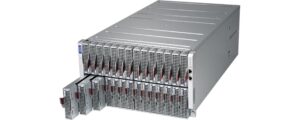The new dimension of digitalization is enormous and global data volumes will only multiply exponentially in the future with video streaming, virtual conferences, cloud services, cryptocurrencies and many other digital applications. Experts estimate a 146-fold increase in data in just 15 years.
 According to the US International Trade Commission, 175 zettabytes (≙ 175,000,000,000,000,000,000,000 bytes) of data are expected to be reached as early as 2025. Currently, around 8,000 data centers process, store and network these huge volumes of data. In addition to performance and safety, optimizing energy efficiency is fundamental to your profitability and sustainability.
According to the US International Trade Commission, 175 zettabytes (≙ 175,000,000,000,000,000,000,000 bytes) of data are expected to be reached as early as 2025. Currently, around 8,000 data centers process, store and network these huge volumes of data. In addition to performance and safety, optimizing energy efficiency is fundamental to your profitability and sustainability.
To meet these requirements and enable the decarbonization of data centers, Super Micro Computer, a provider of IT solutions for cloud, AI/ML, storage and 5G/Edge, is collaborating with Infineon Technologies by choosing its stage-stage semiconductor products. high efficiency energy.
“When developing our green computing platforms, we chose leading vendors who share our focus on energy efficiency to reduce power consumption,” said Manhtien Phan, vice president of server technology at Supermicro. “With Supermicro solutions and Infineon technologies, you can decrease system power consumption, which reduces overall data center power usage, minimizing impact on the environment.”
Power usage effectiveness (PUE) measurement divides the total power supplied to the data center by the actual power consumed by IT equipment. An ideal PUE value is 1.0, which means that all the power needed by a data center is in the actual computing devices, not overhead costs such as cooling or power conversion.
According to a recent survey, IT and data center managers reported an average annual PUE ratio of 1.57 in their largest data center, indicating that there is room for improvement in the runaway cooling and power costs, along with reducing the CO 2 footprint.
Supermicro's green computing platform can significantly improve PUE. Specifically, Supermicro's MicroBlade family offers the best server density for a variety of processors, up to 112 1-socket Atom nodes, 56 1-socket Xeon nodes, and 28 2-socket Xeon nodes in 6U. This can be effortlessly deployed at scale and provisioned in volume with its data center-friendly features and designs, including open-air cooling and battery backup power (BBP).
MicroBlade can provide up to 86% improvement in energy efficiency and 56% improvement in density when compared to standard 1U rackmount servers.
“Data center cooling is responsible for a large part of energy consumption. Our energy-efficient TDA21490 and TDA21535 power stages are ideal for data centers to reduce heat dissipation,” said Adam White, president of Infineon’s Power Systems and Sensors Division. “These semiconductors provide high temperature tolerance and excellent reliability to enable free air cooling for the server, further improving power efficiency for the customer data center and providing greater energy efficiency.”
The MicroBlade server uses Infineon's OptiMOS TDA21490 and TDA21535 integrated power stages. The TDA21490 enables a robust and reliable voltage regulator design for high-performance xPUs, ASICs, and SoCs used in server, memory, AI, and networking applications. The device offers best-in-class efficiency with its OptiMOS power MOSFETs in a thermally efficient package. The low quiescent current driver enables a deep sleep mode to further increase efficiency at light loads and provides excellent current monitoring that significantly improves system performance.
In addition to robust OptiMOS MOSFET technology, the TDA21490's comprehensive fault protection feature further increases system robustness and reliability.
The TDA21535 incorporates a quiescent low-current synchronous buck-gate driver IC in a co-package with high- and low-side MOSFETs and an active diode structure that achieves low values for body diode forward voltage ( VSD ) similar to a Schottky barrier diode with little reverse recovery charge. The internal temperature-compensated MOSFET current measurement algorithm in the TDA21535 achieves superior current measurement accuracy compared to best-in-class controller-based induction DC resistance measurement methods.
Operation at a switching frequency of up to 1.5 MHz enables high-performance transient response and allows output inductance and capacitance to be reduced while maintaining efficiency.

